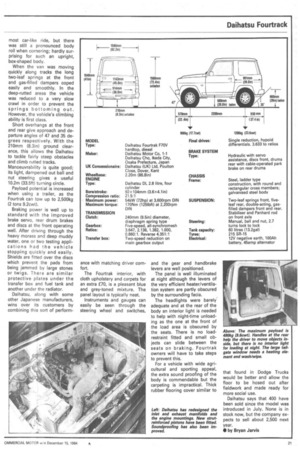Versatile performer
Page 22

Page 23

If you've noticed an error in this article please click here to report it so we can fix it.
MOST ORIENTAL four-wheeldrive vehicles have a well appointed sporty style that seeks to ensure continued interest from a market sector that the Japanese themselves seem to have engendered.
Although these vehicles are often portrayed as expensive playthings, they are also capable little workhorses.
Earlier this year when Daihatsu revised its Fourtrak range it paid the same attention to detail with new interior and body styling that it applied to the driveline and suspension.
The short-wheelbase range of four models has two-litre petrol and 2.8-litre diesel engine versions, each available in canopied or hard-topped form.
I tested the van-bodied diesel version carrying a 490 kg (9.6 cwt) payload and it soon became apparent that here was an extremely versatile performer.
Over a distance of 77.8 miles, which included an afternoon ploughing around boggy woodland tracks and a tortuous alpine section, the Fourtrak not only performed well but returned 1 1.7 lit/1 0 Okm (24.2mpg) to boot.
Compared with the larger Land Rover and Trans Cat models, it was more fussy, yet showed a rugged surefootedness that was commendable.
Daihatsu's new 2,765cc diesel engine, which develops 54kW (72hp) at 3,600rpm and peak torque of 170Nm (125Ibft) at 2,200rpm, is extremely flexible whatever the conditions. During the off-road work it functioned well, pulling strongly when required yet maintaining a normal working temperature at all times.
Deep mud and water splashes had little effect on the vehicle's electrics or the engine, with the air intake routed round the back of the righthand headlamp.
All Fourtrack models benefit from the five-speed synchromesh gearbox which, helped by a light clutch pedal, selects very smoothly indeed.
On motorways my test vehicle cruised happily along in fifth gear yet was equally capable of dodging through heavy city traffic using the lower gears.
Behind the gear lever, a single transfer lever selects two or four-wheel drive in high ratio. It follows through in dogleg fashion to the four-wheel, low-ratio drive position. On our test vehicle it operated well between the first two positions but after that moved very stiffly indeed, eventually chunking into engagement.
With its slightly broader 1,320mm (52.0in) front track and an increased 2,205mm (86.8in) wheelbase, the improved Fourtrak suspension is said to give a much softer ride without affecting the on/offroad performance.
On hard roads the test vehicle produced an easy, al most car-like ride, but there was still a pronounced body roll when cornering; hardly surprising for such an upright, box-shaped body.
When the van was moving quickly along tracks the long two-leaf springs at the front and gas-filled dampers coped easily and smoothly. In the deep-rutted areas the vehicle was reduced to a very slow crawl in order to prevent the springs bottoming out. However, the vehicle's climbing ability is first class.
Short overhangs at the front and rear give approach and departure angles of 47 and 35 degrees respectively. With the 210mm (8.3in) ground clearance, this allows the Daihatsu to tackle fairly steep obstacles and climb rutted tracks.
Manoeuvrability is quite good; its light, dampened out ball and nut steering gives a useful 10.2m (33.5ft) turning circle.
Payload potential is increased when using a trailer, as the Fourtrak can tow up to 2,500kg (2 tons 9.2cwt).
Braking power is well up to standard with the improved brake servo, rear drum brakes and discs at the front operating well. After driving through the heavy morass and deep muddy water, one or two testing applications had the vehicle stopping quickly and easily. Shields are fitted over the discs which prevent the pads from being jammed by large stones or twigs. There are similar protective plates under the transfer box and fuel tank and another under the radiator.
Daihatsu, along with some other Japanese manufacturers, wins over its customers by combining this sort of perform
ance with matching driver comfort.
The Fourtrak interior, with cloth upholstery and carpets for an extra £70, is a pleasant blue and grey-toned mixture. The panel layout is typically neat.
Instruments and gauges can easily be seen through the steering wheel and switches, and the gear and handbrake levers are well positioned.
The panel is well illuminated at night although the levers of the very efficient heater/ventilation system are partly obscured by the surrounding facia.
The headlights were barely adequate and at the rear of the body an interior light is needed to help with night-time unloading as the one at the front of the load area is obscured by the seats. There is no loadrestraint fitted and small objects can slide between the seats on braking. Fourtrak owners will have to take steps to prevent this.
For a vehicle with wide agricultural and sporting appeal, the extra sound proofing of the body is commendable but the carpeting is impractical. Thick rubber flooring cover similar to that found in Dodge Trucks would be better and allow the floor to be hosed out after fieldwork and made ready for more social use.
Daihatsu says that 400 have been sold since the model was introduced in July. None is in stock now, but the company expects to sell about 2,500 next year.
• by Bryan Jarvis












































































